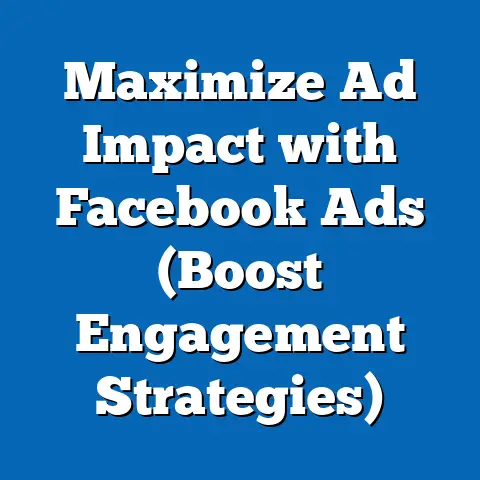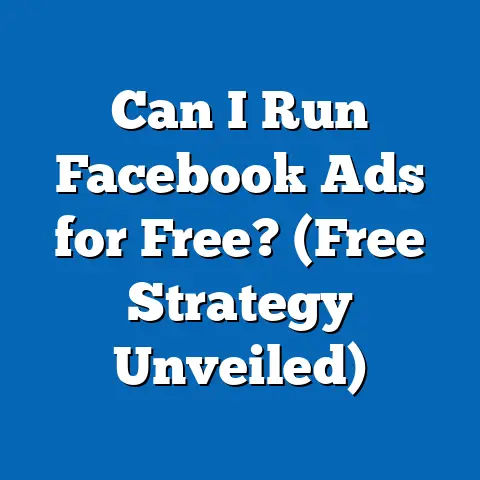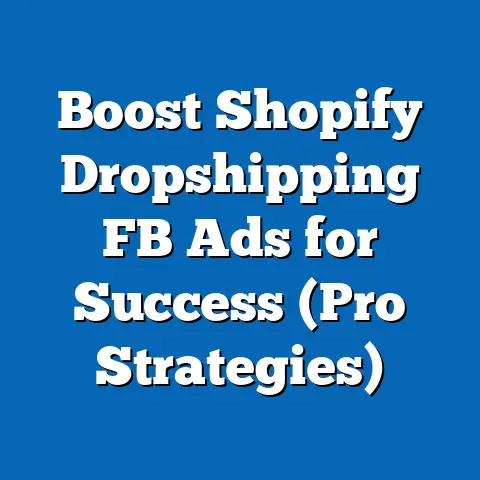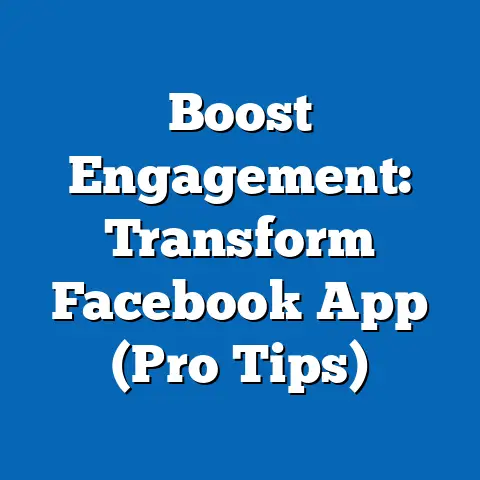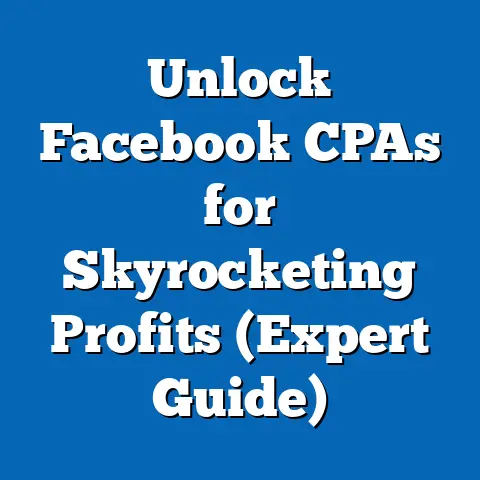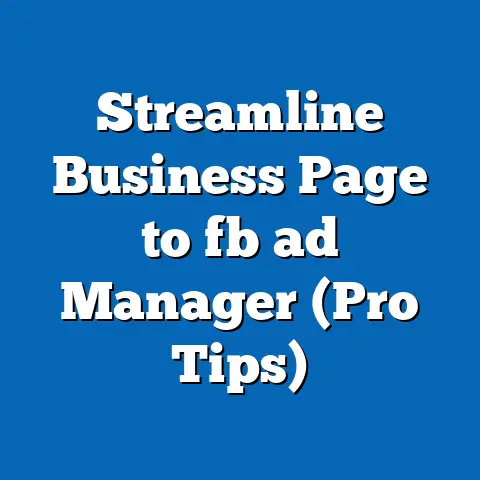Master Facebook Ads Opt-Out (Unlock User Retention Strategies)
In the ever-evolving digital landscape, the power to opt-out of Facebook ads isn’t just a user choice; it’s a golden opportunity for brands to unlock unprecedented user retention strategies. I’ve seen firsthand how businesses that adapt to this shift not only survive but thrive.
Facebook advertising has become a cornerstone of modern marketing, offering unparalleled reach and sophisticated targeting. Yet, with increasing awareness of data privacy, more users are opting out of personalized advertising. This article dives deep into understanding this opt-out phenomenon and, more importantly, how you can leverage it to build lasting relationships with your audience. It’s about shifting from simply targeting to truly connecting.
The Landscape of Facebook Advertising
Facebook’s advertising ecosystem is a behemoth, boasting billions of users and sophisticated targeting capabilities. As someone who’s spent years navigating its intricacies, I can attest to its power. We’re talking about reaching specific demographics, interests, and behaviors with laser precision. This data-driven approach has revolutionized marketing, allowing businesses to deliver tailored messages to the right people at the right time.
However, the rise of data privacy concerns and regulations like GDPR (General Data Protection Regulation) and CCPA (California Consumer Privacy Act) have significantly impacted this landscape. These regulations empower users to control their data, leading to a surge in opt-out rates. As a result, advertisers must now navigate a world where personalized advertising is becoming less prevalent. I believe that compliance with these regulations is not just a legal requirement but a moral one.
Takeaway: Facebook advertising offers immense potential, but evolving privacy regulations demand a more user-centric approach.
Understanding the Opt-Out Phenomenon
Opting out, in the context of Facebook ads, means users choose to limit the data Facebook collects and uses to personalize their ad experiences. This can involve disabling ad tracking, limiting the use of personal information for targeting, or opting out of interest-based advertising altogether.
I’ve been closely monitoring opt-out trends, and the numbers are significant. Studies show a steady increase in users limiting data sharing, particularly among younger demographics. This isn’t just a fleeting trend; it’s a fundamental shift in user behavior.
Several factors drive this phenomenon. Privacy fears are a major contributor. Users are increasingly concerned about how their data is collected, stored, and used by tech giants. Ad fatigue also plays a role. Constant exposure to irrelevant or intrusive ads can lead to negative brand perceptions and a desire to opt-out.
Takeaway: Opt-out rates are rising due to privacy concerns and ad fatigue, signaling a need for more respectful and engaging advertising practices.
The Consequences of Opting Out
When users opt out, the consequences for businesses can be both challenging and, surprisingly, beneficial.
On the negative side, the loss of targeted reach is a primary concern. Without personalized data, advertisers struggle to deliver relevant ads to specific audiences, potentially leading to lower conversion rates and wasted ad spend. I’ve seen campaigns suffer when targeting becomes too broad due to opt-outs.
However, there are also potential upsides. A reduced reliance on personalized ads can force businesses to focus on creating more engaging and valuable content. It can also encourage a shift towards more organic marketing strategies, such as building a strong social media presence and fostering genuine community engagement.
I remember one client who initially panicked when opt-out rates increased. But by focusing on creating high-quality, informative content, they actually saw an increase in organic reach and engagement, ultimately strengthening their brand image.
Takeaway: While opt-outs can limit targeted reach, they also present an opportunity to focus on creating more valuable and engaging content.
Unlocking User Retention Strategies
The key to thriving in this new landscape is to adopt innovative user retention strategies that go beyond traditional personalized advertising. Here’s where the real magic happens:
1. Engagement through Value:
The cornerstone of any successful retention strategy is providing real value to your audience. This means creating content that educates, entertains, or solves a problem. I’ve found that content that genuinely helps people is far more effective than generic promotional material.
- Educational Content: Create blog posts, guides, and videos that provide valuable information related to your industry or product.
- Entertaining Content: Share engaging stories, humorous posts, or interactive content that captures attention and sparks interest.
- Community Engagement: Foster a sense of community by encouraging discussions, responding to comments, and creating opportunities for users to connect with each other.
2. Building Trust and Transparency:
In today’s world, trust is paramount. Users are more likely to engage with brands that are transparent about their data practices and respect their privacy.
- Clearly Communicate Data Usage: Explain how you collect, use, and protect user data in a clear and concise manner.
- Respect Privacy Preferences: Honor users’ opt-out choices and avoid using intrusive tracking techniques.
- Provide Data Control Options: Give users control over their data by allowing them to access, modify, or delete their personal information.
3. Alternative Marketing Channels:
Don’t put all your eggs in one basket. Diversifying your marketing channels is crucial for reaching users who have opted out of Facebook ads.
- Email Marketing: Build an email list and nurture your audience with valuable content and personalized offers.
- Influencer Collaborations: Partner with influencers who resonate with your target audience to reach a wider audience and build credibility.
- Organic Social Media Strategies: Focus on creating engaging content that organically reaches your audience on social media platforms.
4. Personalization Without Intrusion:
Personalization is still valuable, but it doesn’t have to be intrusive. You can create personalized experiences without relying on invasive tracking techniques.
- First-Party Data: Leverage data that users voluntarily provide, such as purchase history or survey responses, to personalize their experiences.
- Customer Feedback: Actively solicit feedback from customers to understand their needs and preferences and tailor your offerings accordingly.
- Contextual Personalization: Use contextual cues, such as location or time of day, to deliver relevant messages without relying on personal data.
5. Loyalty Programs and Incentives:
Loyalty programs can be a powerful tool for retaining customers and encouraging them to engage with your brand, even if they’ve opted out of ads.
- Reward Frequent Purchases: Offer discounts, exclusive deals, or free gifts to customers who frequently purchase your products or services.
- Incentivize Engagement: Reward customers for engaging with your brand on social media, writing reviews, or referring friends.
- Create Exclusive Experiences: Offer exclusive access to events, content, or products to loyalty program members.
I’ve seen loyalty programs transform casual customers into brand advocates, fostering a sense of belonging and driving long-term retention.
Takeaway: Diversify your strategies by focusing on value, transparency, alternative channels, non-intrusive personalization, and loyalty programs.
Measuring Success in Retention
Measuring the effectiveness of your retention strategies is crucial for continuous improvement. It’s about tracking the right KPIs and adapting your approach based on the data.
Here are some key metrics and KPIs to focus on:
- Customer Retention Rate: The percentage of customers who remain loyal to your brand over a specific period.
- Customer Lifetime Value (CLTV): The total revenue a customer is expected to generate throughout their relationship with your brand.
- Engagement Rate: The level of interaction users have with your content, including likes, comments, shares, and clicks.
- Website Traffic: The number of visitors to your website, indicating the reach and effectiveness of your marketing efforts.
- Conversion Rate: The percentage of website visitors who complete a desired action, such as making a purchase or signing up for a newsletter.
Tools like Google Analytics, social media analytics platforms, and CRM systems can help you track these metrics and gain valuable insights into your audience’s behavior.
I always advise clients to set clear goals and regularly analyze their data. It’s not enough to simply track the numbers; you need to understand what they mean and how you can use them to optimize your retention strategies.
Takeaway: Track key metrics like retention rate, CLTV, and engagement to measure success and optimize your retention strategies.
Conclusion
Opting out of Facebook ads presents both challenges and opportunities. While the loss of targeted reach can be daunting, it also forces businesses to rethink their marketing strategies and focus on building genuine connections with their audience.
By prioritizing value, transparency, and diversification, you can unlock innovative user retention strategies that drive long-term growth. Embrace the opt-out phenomenon as a catalyst for change and create a more sustainable and user-centric approach to marketing.
Remember, it’s not just about reaching people; it’s about building lasting relationships.
Call to Action
I encourage you to share your experiences and strategies related to Facebook ads and user retention in the comments below. Let’s learn from each other and create a community dialogue around this important topic. What strategies have you found most effective? What challenges have you faced? Your insights can help others navigate this evolving landscape and build stronger, more resilient brands.

